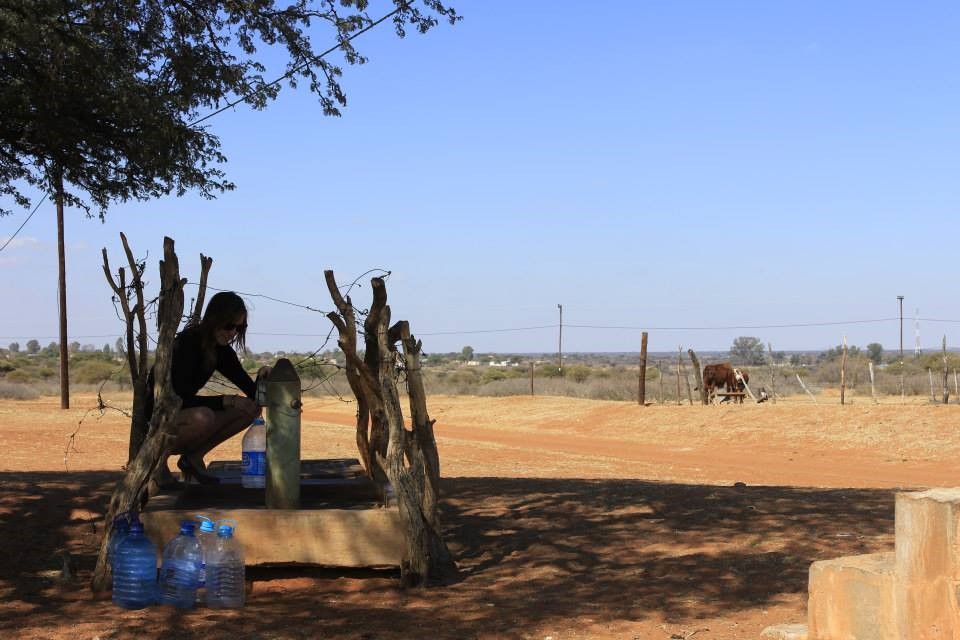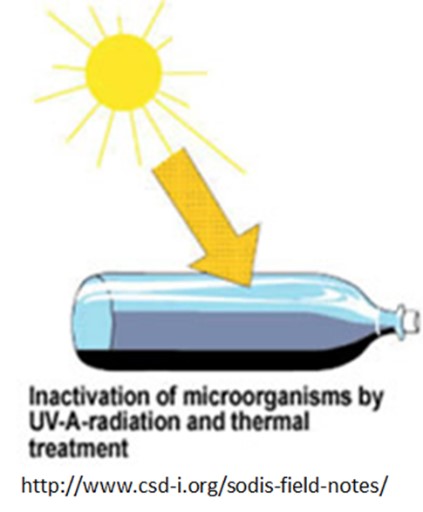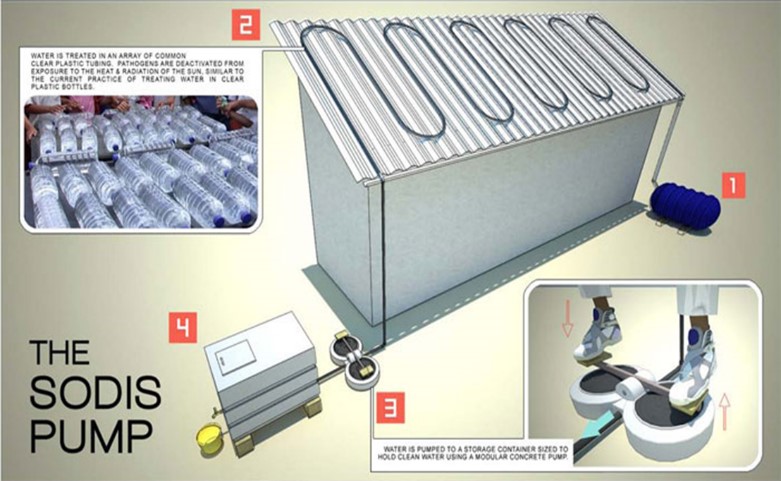Can the Power of the Sun be used for providing safe water to developing countries?

By Oumoule Ndiaye, Graduate Student in Food Science and Technology, Virginia Tech, Water INTERface IGEP
Solar drinking water disinfection – SODIS for short- was the topic brought and presented this week in the Water for Health Seminar (GRAD 5414) by an interdisciplinary team Julia Byrd (CEE), Razieh Farzad (FST), Anna Fausnacht (HNFE), and Samantha Kostelnik (HNFE).
Research has shown that water is the most important essential nutrient that our body needs in order to ensure and maintain body’s vital functions. (Kleiner, 1999 and Jéquier, et al., 2009). Being aware of that major and life lasting role of water an individual lifetime, the United Nations has classified safe and readily available water used in human consumption as important for public health. Furthermore, since 2010, universal access to clean water and sanitation has been considered as a basic human right by United Nations (WHO Drinking-water Fact Sheet N°391 June 2015).
But is clean and safe water accessible as needed to anybody in our planet?
Not at all and the number of people affected is alarming; 663 million of people in the globe do not have access to improved drinking water (WHO Drinking-water Fact Sheet N°391 June 2015). Likewise, the number of yearly lives lost due to diarrheal diseases that emerge from unsafe water and lack of sanitation is just incredible. An estimated 2 million people perish, with children younger than 5 years in developing countries as the the most susceptible group (WHO 2016, Mathers et al, 2009). In addition to this, in some urban areas, the way of tapping municipal water pipes sometimes leads to a recontamination of the water supply chain (McGoogan et al, 2012).
Are there any actions that are being taken in a sense to eradicate or lessen this overwhelming situation while the global population continues growing?
Yes, absolutely, because having access to potable, clean, and safe water is not a luxury; it is a necessity. Furthermore, studies and reports on what people are experiencing in some parts of the world have raised more awareness among the scientific community but also among leaders. That is why scientists and engineers from diverse horizons have come up with several methods of water treatment including the Point-of-Use Water Treatment. Many water purification methods have been designed for these regions such as Chlorination with Safe Storage, Combined Coagulant-Chlorine Disinfection Systems, Ceramic Filter Biosand Filter, and SODIS and of course the oldest method boiling water.
What is SODIS and how does it work?
SODIS is a Point-of-Use Water Treatment which has emerged from Lebanese scientists’ discovery in the 1980s that sunlight can disinfect water. This new technology gained credence after an interdisciplinary research team, consisting of microbiologists, virologists, engineers and water specialists focused on this method (http://www.sodis.ch/about/geschichte/index_EN). Since then, SODIS has been introduced in many countries around the world. The idea is to empower those who have low or no access to safe water to overcome this challenging situation by treating their drinking water on their own. Scientific evidence has shown that Point-of-Use Water Treatment has been associated with a decrease in diarrheal diseases (Fewtrell et al., 2005; Clasen et al. 2007). The introduction of SODIS in India has significantly contributed to decrease of many diarrheal illnesses, by as much as 40% (Rose et al., 2006). The SODIS system includes filling clean bottles with water and exposing them under the sun during an adequate amount of time. The bottles can be plastic (mostly polyethylene-terephthalate (PET)) or glass bottles but they have to be transparent and colorless and the shortest required time is 6 hours. SODIS operates by using ultraviolet radiation (UV) from the sun. The heat coming from the sun help neutralize the amount of pathogen germs (e.g. bacteria, viruses, protozoa and worms) present at a high level in the contaminated water (http://www.sodis.ch/methode/anwendung/index_EN; Dunlop et al., 2011).

SODIS Implementation & cost and advantages and limiting factors
SODIS requirement for implementation, its cost and advantages make it a very affordable Point-of-Use Water Treatment to help satisfy human needs in term of level of hygiene of drinkable water. It does not require much effort or a specific background in water technologies in order to make it work. It is cost effective because requires only easy-to-find bottles and direct sun energy. The most used bottles, from PET material, are reusable, recyclable, sustainable and do not change the quality of the water. SODIS is suitable for regions experiencing water scarcity and lack of sanitation for the little amount of water available to them. Likewise, it is also good for places that have access to sufficient water but not to adequate water treatment plants. However, it presents disadvantages such as the required amount of time for disinfection, which in cases of emergency can compromise the inactivation of some pathogens. Another inconvenience is, the small quantities of water that the containers can hold, which can be a limiting factor for large families, a common scenario in rural areas. If non-biodegradable bottles are used this can be harmful for the environment. In rural areas, people do not make this distinction hence the need of repetitive and effective training for SODIS users. SODIS is less efficient if bottles are scratched and is only feasible in sunny regions. Thus, because of this limiting factors, Project Hope House and Full Belly Project have come with the SODIS Pump, a system which seems more ecofriendly because not using plastic bottles that require selection and more care. SODIS Pump is very practical and requires just an ergonomic modular pump that make water to go from a water source though a well design plastic tubing (accessible to sun heat and UV radiation) to a clean container where consumers have ready to drink water (http://www.sodis.ch/methode/anwendung/index_EN http://projecthopehouse.blogspot.com/2011/03/sodis-pump-water-filtration-system.html).

SODIS and other systems are methods of water treatment that can help diminish the risks and solve many safe water problems that the world is facing. They are suitable in cases of natural catastrophes when water shortage occurs due to earthquakes and hurricanes that suddenly limits or prevents citizens from accessing this vital nutrient. During such disasters, such methods may help save lives. SODIS methods and boiling water are valuable Point-of-Use Water Treatment methods that can help meet some of the United Nations set of eight Millennium Development Goals (MDGs) and maybe that is why the World Health Organization is promoting them.
References
- Kleiner, S. M. (1999 Water: an essential but overlooked nutrient. Journal of the American Dietetic Association, 99(2), 200-206 and Jéquier, et al., 2009).
- World Health Organization. (2016). Mathers, C., Stevens, G., Mascarenhas, M., 2009. Global Health Risks: Mortality and Burden of Disease Attributable to Selected Major Risks. World Health Organization
- (McGoogan, K. G., Conroy, R. M., Mosler, H. J., du Preez, M., Ubomba-Jaswa, E., & Fernandez-Ibanez, P. (2012). Solar water disinfection (SODIS): a review from bench-top to roof-top. Journal of hazardous materials, 235, 29-46.
- http://www.sodis.ch/about/geschichte/index_EN accessed on 11/05/2016 ).
- Fewtrell, L., Kaufmann, R. B., Kay, D., Enanoria, W., Haller, L., & Colford, J. M. (2005). Water, sanitation, and hygiene interventions to reduce diarrhoea in less developed countries: a systematic review and meta-analysis. The Lancet infectious diseases, 5(1), 42-52.
- Clasen, T., Schmidt, W.-P., Rabie, T., Roberts, I. & Cairncross, S. (2007). Interventions to improve water quality for preventing diarrhoea: systematic review and meta-analysis. Br. Med. J. 334(7597), 782–785.
- Rose, A., Roy, S., Abraham, V., Holmgren, G., George, K., Balraj, V., Abraham, S., Muliyil, J., Joseph, A. & Kang, G. (2006). Solar disinfection of water for diarrheal prevention in southern India. Arch Dis Child 91, 139–141.
- (http://www.sodis.ch/methode/anwendung/index_EN accessed on 11/05/2016
- Dunlop, P. S. M., Ciavola, M., Rizzo, L., & Byrne, J. A. (2011). Inactivation and injury assessment of Escherichia coli during solar and photocatalytic disinfection in LDPE bags. Chemosphere, 85(7), 1160-1166.
- http://www.sodis.ch/methode/anwendung/index_EN accessed on 11/05/2016
- http://projecthopehouse.blogspot.com/2011/03/sodis-pump-water-filtration-system.html accessed on 11/05/2016


